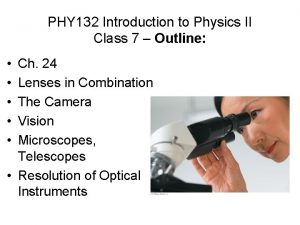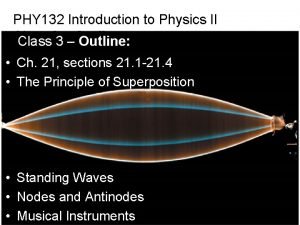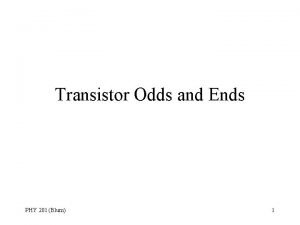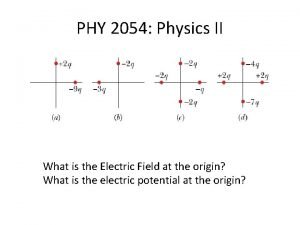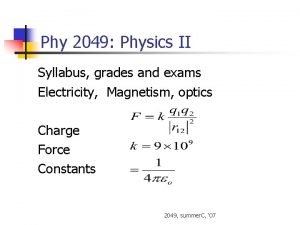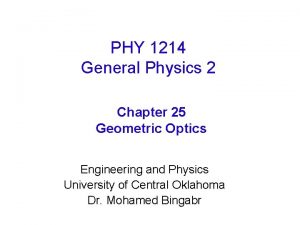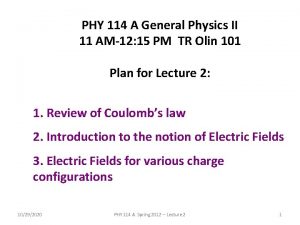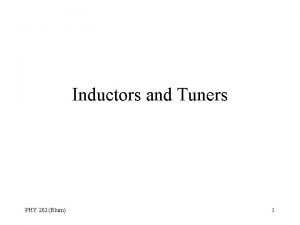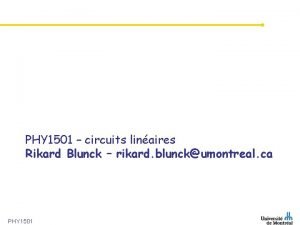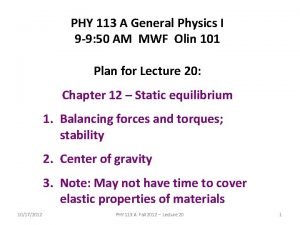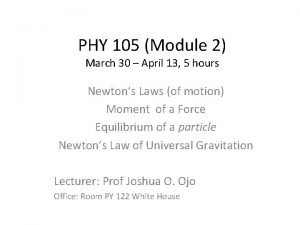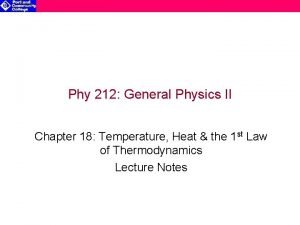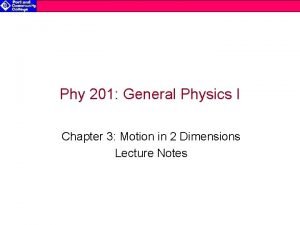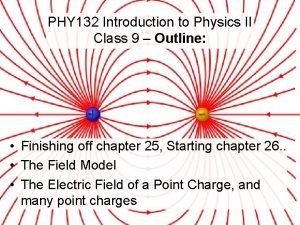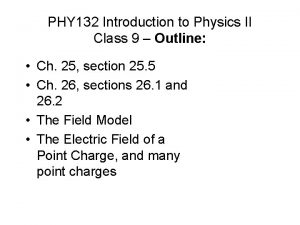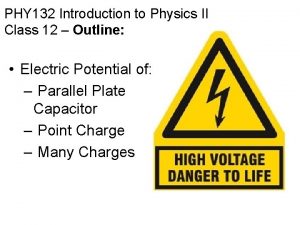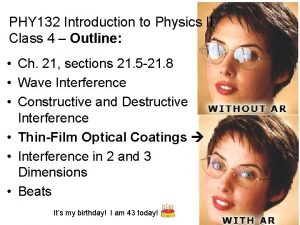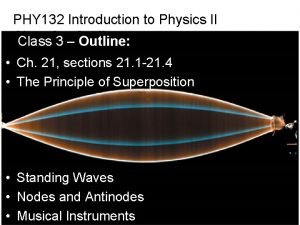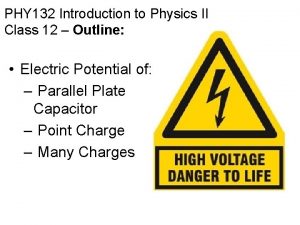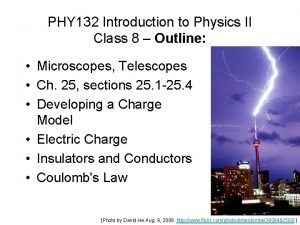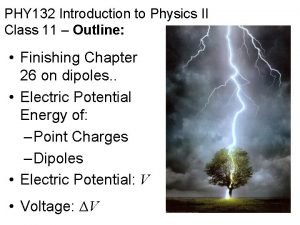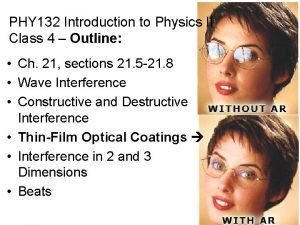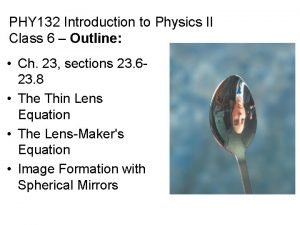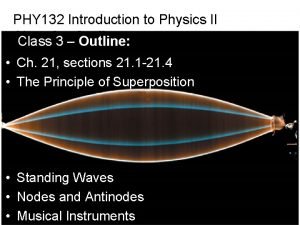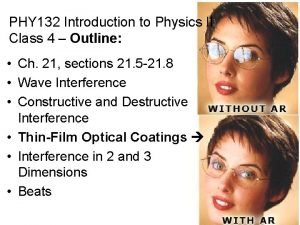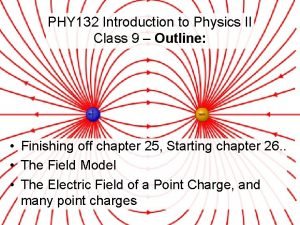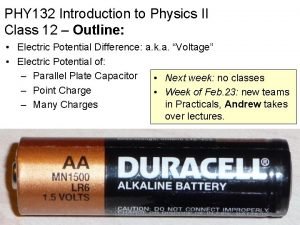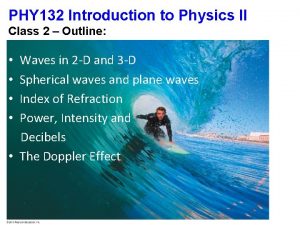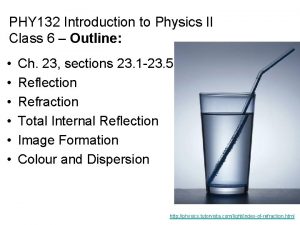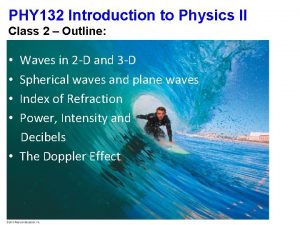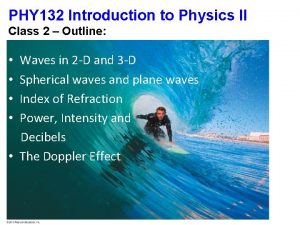PHY 132 Introduction to Physics II Class 2







![Waves in Two and Three Dimensions [Animation courtesy of Dan Russell, Penn State] Waves in Two and Three Dimensions [Animation courtesy of Dan Russell, Penn State]](https://slidetodoc.com/presentation_image/26713302017e7c647c6ebfa84c0775fc/image-8.jpg)

























- Slides: 33

PHY 132 Introduction to Physics II Class 2 – Outline: Waves in 2 -D and 3 -D Spherical waves and plane waves Index of Refraction Power, Intensity and Decibels • The Doppler Effect • •

Quick. Check 20. 6 i-Clicker Discussion Question The period of this wave is A. 1 s. B. 2 s. C. 4 s. D. Not enough information to tell. The postal code of University of Toronto is M 5 S 1 A 1.

Class 2 Preclass Quiz on Mastering. Physics § This was due this morning at 8: 00 am § 688 students submitted the quiz on time § 51% of students answered correctly: The “phase” of a sinusoidal wave is the argument of the sine function (what is in the brackets) § The phase, ϕ(x, t) = kx – ωt + ϕ 0, is a function of both x-position and time.

Class 2 Preclass Quiz on Mastering. Physics § 89% answered correctly: The speed of light in a material is determined by the index of refraction. § 92% answered correctly: When a source is moving away from an observer, the observed frequency is changed due to the motion (also the wavelength, but that was not a choice listed) § 93% answered correctly: The sound intensity level in decibels is related to the logarithm of the intensity. § 93% answered correctly: Human ears can detect frequencies in the range 20 Hz up to 20, 000 Hz

Class 2 Preclass Quiz on Mastering. Physics § Some common or interesting student comments/feedback: § “Do we need to re-register the i. Clicker if it's the same one we used last semester? § ps. guess what I'm imitating: eeeeeee ooooouuu” • YES! You must re-register! Registration is free, and done on portal. utoronto. ca. • Please do NOT register your clicker using the www. iclicker. com web-site. • Register here

Class 2 Preclass Quiz on Mastering. Physics § The Doppler Effect. EEEEEEeeeeeeee

Waves and Wave Fronts – A wave front is the locus of all adjacent points at which the phase of a wave is the same. – Spherical wave fronts of sound spread out uniformly in all directions from a point source. – Electromagnetic waves in vacuum also spread out as shown here.
![Waves in Two and Three Dimensions Animation courtesy of Dan Russell Penn State Waves in Two and Three Dimensions [Animation courtesy of Dan Russell, Penn State]](https://slidetodoc.com/presentation_image/26713302017e7c647c6ebfa84c0775fc/image-8.jpg)
Waves in Two and Three Dimensions [Animation courtesy of Dan Russell, Penn State]

i-Clicker Discussion Question Quick. Check 20. 8 A spherical wave travels outward from a point source. What is the phase difference between the two points on the wave marked with dots? A. B. C. D. E. /4 radians. /2 radians. 7 radians.

The Index of Refraction • Light waves travel with speed c in a vacuum, but they slow down as they pass through transparent materials such as water or glass or even, to a very slight extent, air. • The speed of light in a material is characterized by the material’s index of refraction n, defined as

Index of Refraction for various substances Substance Index of Refraction, n Ice (H 2 O) 1. 309 Water (H 2 O) at 20°C 1. 333 Glycerine at 20°C 1. 473 Crown glass (typical value) 1. 52 Rock salt (Na. Cl) 1. 544 Quartz (Si. O 2) 1. 544 Diamond (C) 2. 417

i-Clicker Discussion Question Quick. Check 20. 9 A light wave travels, as a plane wave, from air (n = 1. 0) into glass (n = 1. 5). Which diagram shows the correct wave fronts?

Index of Refraction and the Wave Aspects of Light • The frequency f of a wave does not change when passing from one material to another. • In any material, v = λf ; since f is the same in any material as in vacuum and v is always less than the wave speed c in vacuum, λ is also correspondingly reduced. • When a wave passes from one material into a second material the waves get “squeezed” (the wavelength gets shorter) if the wave speed decreases and get “stretched” (the wavelength gets longer) if the wave speed increases.

Wave intensity • The intensity of a wave is the average power it carries per unit area. • If the waves spread out uniformly in all directions and no energy is absorbed, the intensity I at any distance r from a wave source is inversely proportional to r 2.

Power and Intensity § When plane waves of power P impinge on area a, we define the intensity I to be:

Example 20. 9. A laser pointer emits 1. 0 m. W of light power into a 1. 0 mm diameter laser beam. What is the intensity of the laser beam?

Intensity of Spherical Waves § If a source of spherical waves radiates uniformly in all directions, then the power at distance r is spread uniformly over the surface of a sphere of radius r. § The intensity of a uniform spherical wave is:

Intensity and Decibels § Human hearing spans an extremely wide range of intensities, from the threshold of hearing at 1 × 10 12 W/m 2 (at midrange frequencies) to the threshold of pain at 10 W/m 2. § If we want to make a scale of loudness, it’s convenient and logical to place the zero of our scale at the threshold of hearing. § To do so, we define the sound intensity level, expressed in decibels (d. B), as: where I 0 = 1 10 12 W/m 2.

Sound Intensity Levels – Representative Values Source Military jet aircraft 30 m away Threshold of pain Elevated train Busy street traffic Quiet radio in home Average whisper Threshold of hearing at 1000 Hz Sound Intensity Level, β (d. B) Intensity, I (W/m 2) 140 102 120 90 70 40 20 0 1 10− 3 10− 5 10− 8 10− 10 10− 12

Intensity and Decibels § From this morning’s preclass quiz: “I'm not sure how to answer "stop to think 20. 6". Could you perhaps go over that in lecture? Thanks!” § Four trumpet players are playing the same note. If three of them suddenly stop, how much does the sound intensity level drop by? § Answer: ratio (I 2/I 1) = ¼ = 0. 25 : the actual intensity in Watts/m 2 has reduced by a factor of four. § Recall: log(a) – log(b) = log(a/b)

i-Clicker Discussion Question • A sound level of 10 decibels has 10 times more intensity than a sound level of zero decibels. • A sound level of 20 decibels has ___ times more intensity than a sound level of zero decibels. A. 10 B. 20 C. 50 D. 100 E. 200

i-Clicker Discussion Question • When you turn up the volume on your ipod, the sound originally entering your ears at 50 decibels is boosted to 80 decibels. By what factor is the intensity of the sound has increased? A. 1 (no increase) B. 30 C. 100 D. 300 E. 1000

The Doppler effect: Moving listener • An observer moving toward a stationary source hears a frequency that is higher than the at-rest frequency f 0.

The Doppler effect: Moving source • When a source is moving away from an observer, the waves behind the source are stretched to a longer wavelength. • Since f = v/λ, a longer wavelength corresponds to a lower frequency.

The Doppler effect • The Doppler effect explains the observed change in pitch of the siren on a fire engine or ambulance. • The frequency is high (f > f 0) when it is approaching you. • The frequency is low (f < f 0) when it is moving away from you.

i-Clicker Discussion Question Which statement is true? Valerie is standing in the middle of the road, as a police car approaches her at a constant speed, v. The siren on the police car emits a “rest frequency” of f 0. A. The frequency she hears rises steadily as the police car gets closer and closer. B. The frequency she hears steadily decreases as the police car gets closer and closer. C. The frequency she hears does not change as the police car gets closer.

i-Clicker Discussion Question Which statement is true? Valerie is standing in the middle of the road, listening to the siren of a police car approaching her at a constant speed, v. Daniel is listening to a similar siren on a police car that is not moving. A. The frequency Daniel hears is lower than the frequency Valerie hears. B. The frequency Daniel hears is higher than the frequency Valerie hears. C. The frequencies that Daniel and Valerie hear are exactly the same.

The Doppler Effect The frequencies heard by a stationary observer when the sound source is moving at speed v 0 are The frequencies heard by an observer moving at speed v 0 relative to a stationary sound source emitting frequency f 0 are

Doppler Shift for Light • When a light source is moving away from you, the spectrum is shifted toward the red. • When a light source is moving toward you, the spectrum is shifted toward the blue.

Doppler Shift for Light • The Doppler shift can be observed in the headlights of cars on the highway. • The cars moving away from you appear more red, while the cars moving toward you appear more blue -ish or white.

Doppler Shift for Light wr wthhh hhhh? ? on g • The Doppler shift can be observed in the headlights of cars on the highway. • The cars moving away from you appear more red, while the cars moving toward you appear more blue -ish or white.

Doppler Shift for Light (yes, really!) • The Doppler shift can be observed with carefully obtained spectra of very fast moving objects like stars • There is a slight shift in “absorption lines”

Before Class 3 on Monday • Please read Knight pages 591 -603: Ch. 21, sections 21. 1 -21. 4 • Please do the short pre-class quiz on Mastering. Physics by Sunday evening. • Something to think about: What is the difference between a traveling wave and a standing wave. Does a standing wave really stand still?
 Nearsightedness physics
Nearsightedness physics Phy 132
Phy 132 Phy 131 past papers
Phy 131 past papers Phy 231 msu
Phy 231 msu Great orthogonality theorem
Great orthogonality theorem Rotational statics
Rotational statics Phy theorem
Phy theorem Phy113
Phy113 Phy 121 asu
Phy 121 asu Ddr phy architecture
Ddr phy architecture Phy 205
Phy 205 Eye accommodation
Eye accommodation Phy 2049
Phy 2049 Phy
Phy Phy
Phy Phy
Phy Atm packet phy
Atm packet phy Phy
Phy Phy 2049
Phy 2049 General physics
General physics Phy 1214
Phy 1214 Phy
Phy Law of motion
Law of motion Complete motion diagram
Complete motion diagram Felix connects a wire coil to an ammeter
Felix connects a wire coil to an ammeter Life phy
Life phy Phy circuit
Phy circuit Applications of magnetism
Applications of magnetism 2012 phy
2012 phy Phy-105 5 discussion
Phy-105 5 discussion Phy 2048c fsu
Phy 2048c fsu Physics heat and temperature
Physics heat and temperature General physics chapters
General physics chapters Vx=vox+axt
Vx=vox+axt
